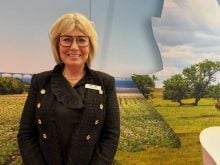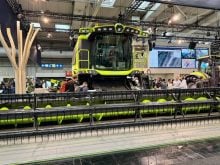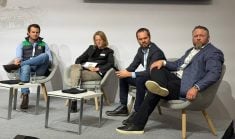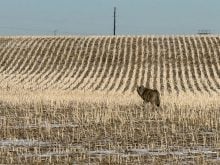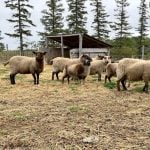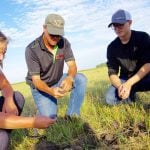LAURA, Sask. – James Robbins and Nettie Wiebe know they are part of a community: A national community, a regional community and their farm’s neighborly community. Their farming life reflects that view.
In the two decades the couple has farmed in central Saskatchewan, the pair has spent nearly as much time working for change as working the land.
Robbins is known for his participation on the Senior Grain Transportation Committee, the Car Allocation Policy Group and formerly the national crop insurance review program. He also represents his local credit union at the provincial level and sits on his local church board. He is holding 10 voluntary board seats and was a candidate in last fall’s Canadian Wheat Board elections.
Read Also

Internet of Things tapped for better emissions insights
Interconnected field sensor fleet allows better soil monitoring coverage and, hopefully, live insights on farm greenhouse gas emissions and nitrogen fertilizer application for farms.
“I was trying to cut down this winter. It didn’t work out that way,” he said.
His partner, Nettie, is best known to most Canadian farmers as the former president of the National Farmers Union for the past four years. She stepped down in December but still remains on numerous boards, including some for the NFU, but says she looks forward to more personal time.
The couple wear their politics openly. Left-leaning and pragmatic, they defend the ideal of the small family farm but recognize the need for economies of scale. Their own operation is 2,440 acres of land, half of which is used for grazing or hay production. They produce cereal grains, oilseeds and pulse crops and have a 40-head cow-calf herd.
“We like the way cattle fit into our farm. Livestock have a role to play in our future plans,” said Robbins.
In recent years the farm has been continuous cropped with a rotation of cereals, mustard or canola and peas and lentils, but the couple has other plans for their cropland. They have reserved a quarter section to be managed without the use of industrial inputs.
“It may be that we rotate cattle around the entire farm,” said Robbins. “Seeding in rotations that permit grazing and crops … whatever is needed to keep weed populations down and produce good crops.”
They try to use weed seeds along with the chaff from the combine as feed for the cattle. They supplement that with hay, including alfalfa grown on saline areas of their land.
“Some of our field boundaries don’t look like the normal ones people are used to seeing. Our land is pretty variable and we try to use it accordingly,” said Robbins.
Wiebe says the reserved land experiment is allowing them to learn what it will take to have an organic farm.
“We need to learn about weed control on an environmentally sustainable farm,” she said. “We know we don’t like to have summerfallow but it may be necessary for organic production. We are learning about it and will be making some budgets this winter to see how much it will cost and how long it will take to make such a change. It still must be viable. We will still need to be making a living from it.”
They say the concept of reducing the farm’s dependence on expensive inputs is something that many producers may have to consider if they wish to remain small and in a community with other farm families in the future.
“I don’t see any limits to the farm size issue. As a farm family needs more land to survive, they will expand and then we will be fewer and further between,” said Wiebe.
The Robbins-Wiebe farm has grown over the years along with couple’s family. With four children, ages 12 to 18 years, they understand the problems faced by families trying to make a success of farm life.
The couple laid out the farmyard in 1979 on “a stubble field.” She was born and raised on a Saskatchewan dairy farm; he, growing up in Saskatoon, had a link with an uncle who farmed at Laura. They started small and had help from their families.
“I thought that after a number of years of hard work that we would then be able to earn a modest, middle class income and be fully supported by the farm,” said Wiebe.
“We’re still waiting for that day to come. It doesn’t seem to be getting that much closer though.”
Off-farm employment
Robbins has a master’s degree in veterinary microbiology and for a time worked off the farm in that field. Now he works as a human resources consultant to boards of
directors.
“It depends on the (farm) year. Some years I need to work a lot in the winter, other years less. This year I’ll need to round up some additional work,” said Robbins, who says the consulting allows him the flexibility he needs.
Wiebe, too, says she will be looking for new off-farm work soon. The former farm group president has a doctorate in philosophy.
“I like the work off the farm. I think many farmers enjoy careers off the farm, but many wish they didn’t have to,” said Wiebe.
Despite their busy careers, Wiebe and Robbins say they always placed family first. They made sure one parent was always at home over-night even in the busiest times. The children, Margaret, 12, Katie, 14, Will, 17, and Martha, 18, have all been involved with work on the farm.
The couple feel another benefit from the “public work” they perform has been the variety of experiences they have been able to provide for their kids. Visitors from around the world stay at the farm regularly.
“Martha and William have both been involved in their school’s SRCs and we can see that they all understand that people need to be involved in their communities,” said Wiebe.
“That is the way a farm works. It is one way farm families spend time together, working … there is something wonderful when we are all out working together … that is something else about a smaller farm that it would terrible for our culture to lose.”




